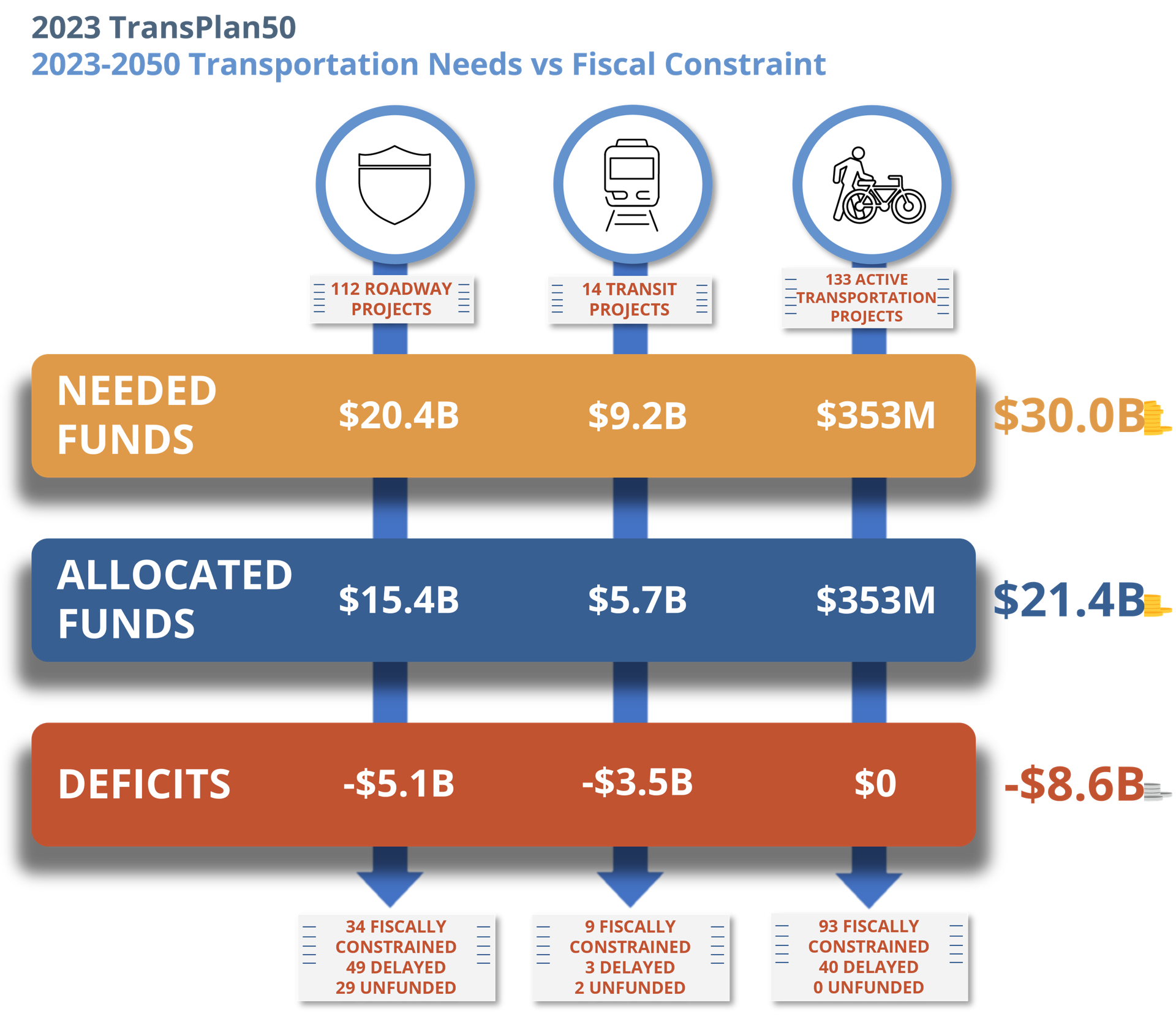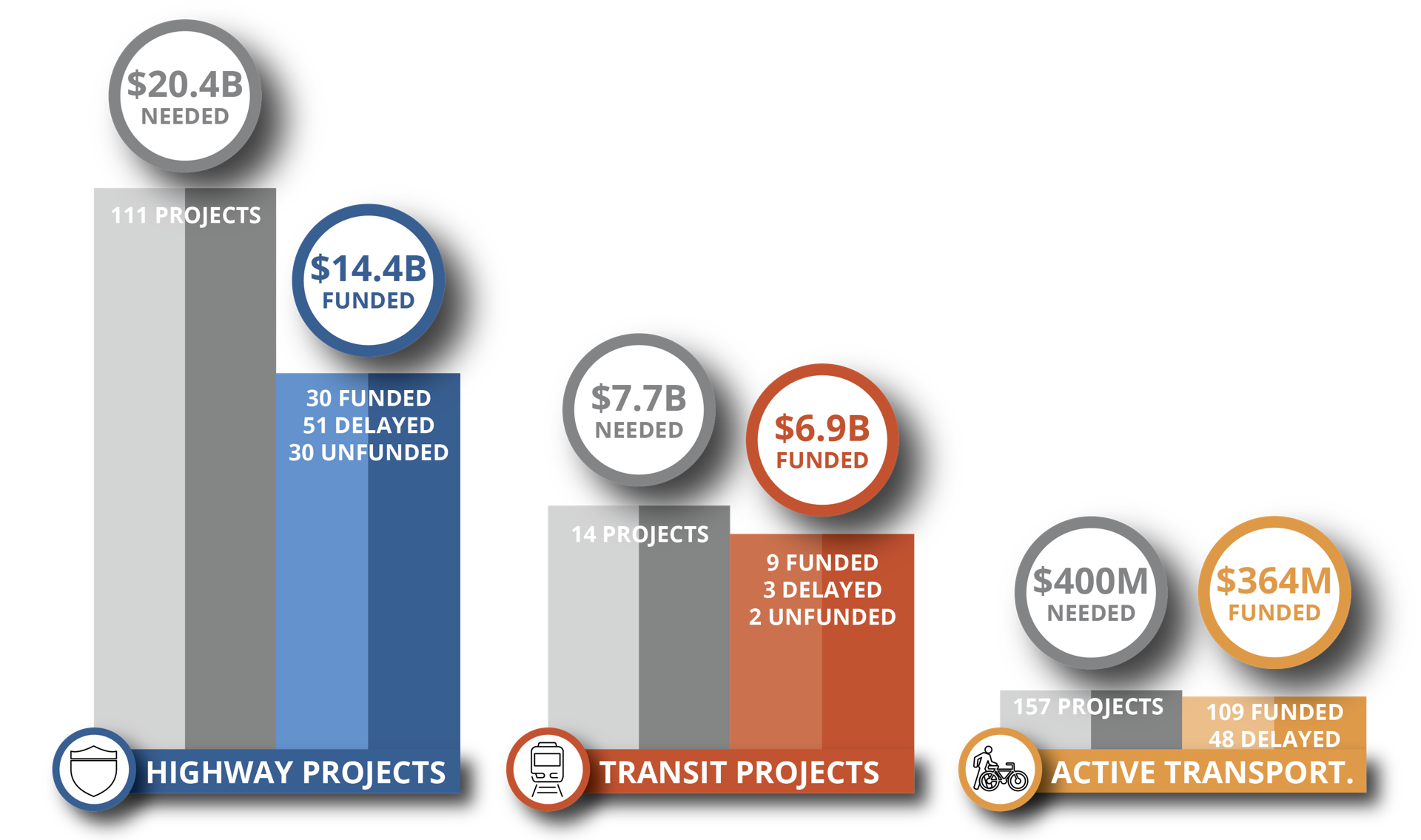The regional transportation plan developed by the Mountainland Metropolitan Planning Organization balances growth, a vibrant economy, and future transportation needs.
Revenues, Costs, Deficit
to Operate, Maintain, and Expand Transportation
Funding assumptions for TransPlan50 are based on coordination between Utah MPOs (Cache, Dixie, Mountainland, and Wasatch Front), the Utah Department of Transportation (UDOT), and the Utah Transit Authority (UTA). Utah follows an advanced practice in developing a statewide Unified Transportation Plan (summary of all MPO, UDOT, and UTA plans). To ensure consistency within the Unified Plan, each individual plan follows a standard set of demographics, financial revenue, cost estimating, and related assumptions.
TransPlan50 funding assumptions are developed for planning purposes only. Transportation funds are generated from several sources, including sales tax, tolls, bonds, state, local, and federal excise taxes on various fuels, and credit assistance sources. Future funding is based on past trends; no outside-the-norm funding assumptions are made. All revenues and costs listed in the plan are shown in 2023 dollars.




Projecting revenues out 47 years is no small task. The rise of electronic communications, the vehicle fleet converting to electric, automated vehicles, how to collect revenue if fuel sales end, and other changes; when and to what magnitude will this changes occur? To comply with federal air quality regulations, TransPlan50 must have reasonable funding assumptions. Because of so many unknowns, future funding assumptions are based on past trends. No outside-the-norm funding assumptions are made. Today, transportation funds are generated from several sources, including sales tax, tolls, bonds, excise taxes on various fuels, and credit assistance sources. Revenues are up $3.1 billion, or 17%, compared to the 2019 update of TransPlan50. Total revenue is projected to be $21.7 billion through 2050.
An area of concern is revenue available for highway projects. The first 10 years of the plan, Phase 1, projected funding available to construct new highway projects is down $1.1 billion, or 16%, compared to the 2019 plan update. A primary funding source of highway construction is the Transportation Investment Fund (TIF), derived from state sales tax. Today, this fund is fully programmed out to 2030, funding $7.2 billion in projects statewide. Utah County received 9.8% or $703 million of these funds. The plan assumes another $500 million by 2032 totaling $1.2 billion for Phase 1, down from $1.8 billion assumed for the same period in the 2019 plan. Funding available through bonding is also down from $768m to $248m. With other funding sources a total of $2.3b is available for construction projects through 2032.
Many factors go into developing costs associated with the plan. What costs are associated with operating and maintaining the current transportation system? How much does it cost to add new capacity to the system to keep up with growth? What impacts does adding new highway lanes, transit lines, or trails have on operating and maintenance costs? How will inflation impact our ability to fund the future system? TransPlan50 estimates the costs and impacts of the current system as well as the future needs. Since the 2019 plan update, rising inflation and land values have increased project costs by 38%. For future years, the plan estimates costs will rise 4% annually. Total costs of operating, maintaining, preserving, and expanding the regional transportation system is projected to cost $28.5 billion.
FISCAL CONSTRAINT AND IMPACTS ON NEEDED PROJECTS
Expansion of the highway system is the primary need underfunded in the plan. The first ten years of the plan, or Phase 1, has limited highway capital funding available. This funding shortfall leaves little funding available to fund immediate-need projects. With limited available funding, only 2 billion of the 13.5 billion in identified needed projects is funded when needed. This equates to 30 of the 111 planned highway projects being funded on time. This impacts later phases in the plan causing 51 highway projects totaling 5.3b to be delayed 10+ years. 30 highway projects totaling 6.2 billion are not funded at all. Transit and active transportation project do not have the same shortfalls in funding and their costs pale in comparison to the highway costs.

The MPO will continue to educate and advocate for funding to support all needed transportation projects within the region. With the highest growth area along the Wasatch Front area, it is critical to identify funding for near-term needs in order to keep the region moving and the economy strong.